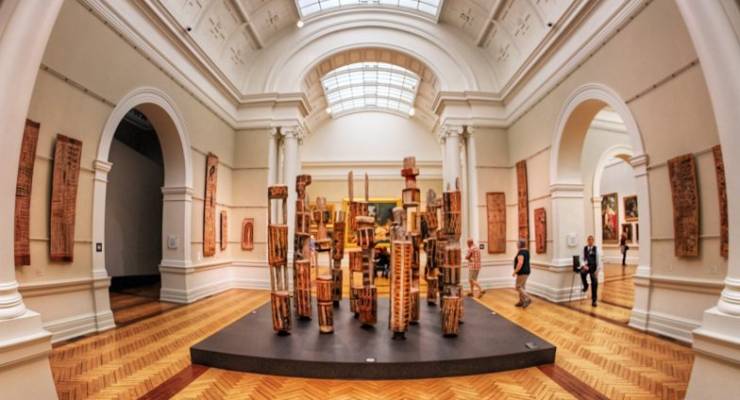
Who gets to govern Australia’s major cultural institutions?
The question has taken new interest in the wake of the Royal Commission into Misconduct in the Banking, Superannuation and Financial Services Industry. That’s because many of the top directors and executives caught up in the royal commission also helm Australia’s largest and most prestigious cultural institutions.
We now know the board of financial giant AMP Limited lied to the financial regulator ASIC. In testimony last week, AMP’s former head of advice Jack Regan lost count of the number of times AMP had misled the regulator. It also emerged that AMP’s board had signed off on a so-called “independent report” to ASIC that had in fact been doctored and edited.
AMP’s chairwoman is Catherine Brenner. Brenner this week moved to fire CEO Craig Meller (or fire him again, as some wags joked, after he had already announced he was stepping down). But an obvious question mark hangs over Brenner herself: just what did Brenner know about the doctored independent report to ASIC?
The royal commission has tabled incredibly damaging emails between AMP’s general counsel Brian Salter and Clayton Utz’s Nick Mavrakis, that quote Catherine Brenner telling Mavrakis to “include a statement to the effect that Craig Meller was unaware of the practices or their illegality”.
Catherine Brenner is also a trustee of the Art Gallery of New South Wales — a gallery that boasts an annual turnover nearing $100 million and audiences exceeding 1.5 million in 2016-17. It also has a priceless collection, the ageless prestige of the Archibald Prize, and $23 million of public funding from NSW taxpayers.
Is a company director that has lied to the financial regulator still an appropriate person to be a trustee of the flagship gallery of Australia’s most populous state?
It doesn’t stop with Brenner either. AMP board director Patty Akopiantz is also a board member of leading theatre company Belvoir. AMP’s third-in-charge executive, Sally Bruce, is the company secretary of the board of the Melbourne Festival.
More broadly, a dense web of links has been spun between senior executives at companies named at the royal commission, and the boards and governance of Australian cultural organisations.
David Armstrong is the chair of the Australian Museum. He has also been a board director of NAB since 2014. Armstrong is chair of NAB’s audit committee. Since 2014, NAB staff have been accused of involvement in a bribery ring, forged signatures, and a major financial advice scandal. There were ongoing revelations about forgeries and false witnessing at NAB at the royal commission just this week.
The cross-directorships go on and on. CommBank chair Catherine Livingstone is on the board of the Australian Ballet. Opera Australia director Brian Benjamin is a merchant banker formerly at Macquarie. The Sydney Symphony Orchestra’s director David Livingstone is the Australian CEO of Citigroup. Carriageworks’ chair Sam Mostyn is a non-executive director at Citi’s retail bank. The Museum of Contemporary Art has a number of former or current bankers on its board including Simon Mordant, Scott Perkins, Anne Sherry and Lorraine Tarabay.
At the top of Australian culture, figures like David Gonski and Nicholas Moore sit at the node of many webs of influence. Macquarie’s Moore, for instance, is one of the highest paid CEOs in Australia. He also chairs the government’s key screen funding agency Screen Australia and is also chair of the trust of the Sydney Opera House.
[Should the Sydney Theatre Company keep Ian Narev on its board?]
As Crikey reported last year, the Sydney Theatre Company’s board is chaired by former Commonwealth Bank CEO Ian Narev. Narev’s tenure in CommBank’s top job was marred by a long succession of scandals and financial improprieties — most notoriously, the CommInsure insurance debacle and 53,000 money laundering charges. At the Royal Commission, CommBank has ‘fessed up as the gold medallist of charging fees for no service.
Is Ian Narev really the best person to helm the board of Australia’s largest theatre company?
When I asked the Sydney Theatre Company that question last year, the response was dismissive. STC’s board and management unreservedly backed him: Narev enjoyed wholehearted support. STC’s CEO Patrick McIntyre and artistic director Kip Williams penned a response praising Narev as a “stimulating, thoughtful chair who has encouraged us to think big and to back vision”.
Perhaps the most telling aspect of STC’s response is its glorification of Narev in fundamentally cultural adjectives. “As a former management consultant, Ian is a creative, challenging and agile thinker,” the board wrote.
Even if we accept it on face value, what does it say about the governance of Australian culture that you can preside over a sustained period of corporate malfeasance at a major bank, and still retain your seat as the chair of the country’s largest funded theatre company?
The intertwining of the top tier of the arts and banking has been going on for years. The reasons are obvious enough: arts organisations want funding and social acceptance, while banking executives and captains of finance want culture (or at least the trappings of it).
The web of influence also reflects changing intellectual fashions. With the rise of neoliberalism, it became accepted wisdom that top business figures, particularly from the banks, were ideal candidates to occupy governance and oversight roles at the top of Australian culture.
But now we know just how bad it is in Australian banking. Major executives and board directors of big Australian banks have been involved in an industry that has run amok for more than a decade. As an industry, big Australian banks have collectively escaped any form of meaningful regulatory oversight, and a rampant culture of malfeasance and corruption appears to have set in.
Given what we know about the culture of the banking industry, is it time for the cultural sector to reassess its close ties to the world of finance?








It’s a bit more complicated than presented here. For many years the board of the Art Gallery of New South Wales was dominated by artists – whose faction fighting made NSW parliamentary politicians look like rank amateurs. In addition there always were Trustees associated with the big end of town – including Charles Lloyd Jones, Lady Fairfax and Harry M Miller. With the Art Gallery of New South Wales Act of 1980 more business people came on board, along with some political appointees. Unfortunately the first person who filled both these requirements was one Edward Obied.
In recent years the trustees have included many philanthropists familiar with governance procedures, and only two artists. The presence of the great medieval tapestry, The Lady and the Unicorn, would not have been possible without the support of Ashley Damer-Dawson, who was able to both support the exhibit with her own funds and enable further support from other sources.
Arts organizations will always need the expertise of those with both an understanding of governance and an ability to network with politicians and others who can provide funding. The problem, which won’t go away, is that as well as those who believe in giving back to the community, there will always be those who use the arts as the ultimate networking opportunity for their own ends. Eliminating those involved in the finance industry from boards of arts organisations won’t solve anything.
It would be wonderful to imagine that the RC might cause things to change in the power structures governing “Big Art”. But I remain deeply pessimistic. 🙁
So much “face” is involved, it’s hard to see how the privileged and powerful few will be able to let go of all those opportunities to smooch with the glam crowd.
Wotta surprise, the yaartz “institutions” (surely a perfect example of what art should never be) has become soiled, compromised and complicit with the BigAr$ed end of town.
In other news, bears are catholic and papal toilet habits suss, coming up after these important messages from our owners..err, valued partners.
Sadly a lot of corporate support for the arts is crassly transactional. I recall one lauded “philanthropist” who openly stated that he had absolutely no interest in the performing arts, but found that funding them paid dividends because it would win favour with the Minister (who usually holds some other useful portfolio!). Slippery practices from the corporate world also creep in. Another recollection is of a Board member who saw nothing wrong with drawing down funds from quarantined trust accounts as an easy means of underwriting deficits.
Collecting Board seats along with an AO is often on a par with, and sometimes concurrent with, acquiring a trophy wife (a majority of donations continue to be sourced from males).
Fortunately, however, there are a few truly disinterested patrons of the arts and they stand out because of their intelligent and passionate commitment to an artform.
“The reasons are obvious enough: arts organisations want funding and social acceptance, while banking executives and captains of finance want culture (or at least the trappings of it).”
The funding bit I can understand, but how much money do these bankers bring in anyway? I doubt they donate much to any arts causes from their own pockets. And the presence of bankers confers social acceptance? Yeah, right!
I’d think the arts organisations would be better off without the taint of bankers.